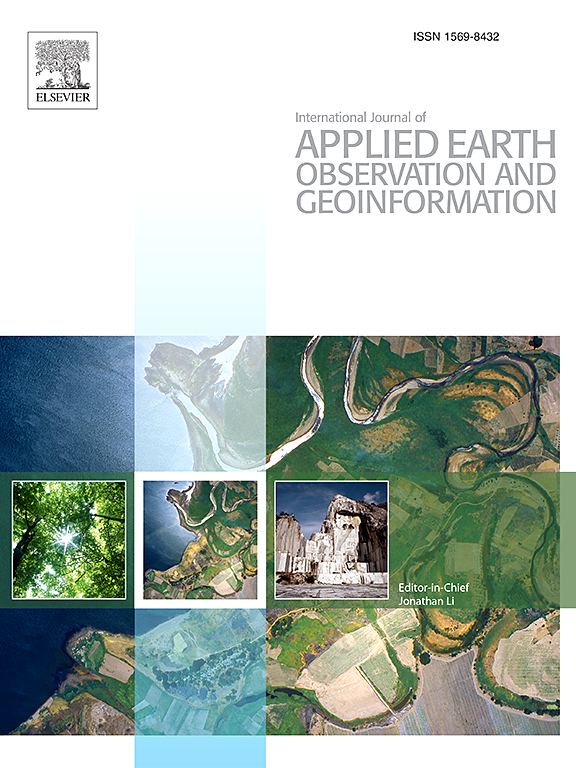基于注意力自回归迁移学习和SMAP数据的亚季节根区土壤湿度准确预测
IF 7.6
Q1 REMOTE SENSING
International journal of applied earth observation and geoinformation : ITC journal
Pub Date : 2025-04-11
DOI:10.1016/j.jag.2025.104532
引用次数: 0
摘要
根区土壤湿度(RZSM)是农业规划和水资源管理的重要水文变量。土壤水分主被动4级(SMAP L4)数据在RZSM估算中具有重要价值。基于SMAP L4的精确分季节RZSM预测对农业管理和干旱评价具有重要意义。目前基于深度学习的RZSM预测模型在长期预测中容易出现误差积累,且SMAP RZSM样本有限,可能导致模型泛化不足。为了解决这些问题,本研究提出了一种基于多头自注意的基于长短期记忆(MAATL)模型的自回归迁移学习模型用于分季节RZSM预测。提出的MAATL模型在美国大陆(CONUS)对1- 60天RZSM预测进行了评估,并与一些消融和长短期记忆(LSTM)模型进行了比较。结果表明,与LSTM相比,MAATL模型的技能显著提高,平均相关系数提高18.26%,均方根误差(RMSE)降低42.55%。利用118个原位土壤湿度站进行预测验证,MAATL模型比GFS和LSTM模型具有更高的预测精度,平均相关技能分别比GFS和LSTM模型提高16.02%和15.08%。这些结果表明,MAATL模型在分季节RZSM预测中具有较好的效果,在农业抗旱方面具有很大的应用潜力。本文章由计算机程序翻译,如有差异,请以英文原文为准。
Accurate sub-seasonal root-zone soil moisture prediction using attention-based autoregressive transfer learning and SMAP data
Root zone soil moisture (RZSM) is an important hydrological variable for agricultural planning and water resources management. The Soil Moisture Active Passive Level 4 (SMAP L4) data demonstrates great value in RZSM estimation. Accurate sub-seasonal RZSM prediction based on SMAP L4 holds great significance for agricultural management and drought assessment. Current deep learning-based RZSM prediction models tend to accumulate error in long-term forecasting and the limited SMAP RZSM samples may result in insufficient model generalization. To address these issues, this study proposes a multi-head self-attention-based autoregressive transfer learning model based on long short-term memory (MAATL) model for sub-seasonal RZSM prediction. The proposed MAATL model is evaluated over the Continental United States (CONUS) for 1- to 60-day RZSM prediction and compared with some ablation and long short-term memory (LSTM) models. The results showed that compared with LSTM, the skills of the MAATL model were significantly improved, with an average correlation coefficient increase of 18.26% and a root mean square error (RMSE) reduction of 42.55%. Furthermore, 118 in-situ soil moisture stations are used for predictive validation and the proposed MAATL model demonstrates higher accuracy compared to the Global Forecast System (GFS) and the LSTM model, with an average correlation skill improvement of 16.02% and 15.08% for MAATL over GFS and LSTM, respectively. These findings indicate superior performance for the proposed MAATL model in sub-seasonal RZSM prediction, which has great potential for agricultural drought preparations.
求助全文
通过发布文献求助,成功后即可免费获取论文全文。
去求助
来源期刊

International journal of applied earth observation and geoinformation : ITC journal
Global and Planetary Change, Management, Monitoring, Policy and Law, Earth-Surface Processes, Computers in Earth Sciences
CiteScore
12.00
自引率
0.00%
发文量
0
审稿时长
77 days
期刊介绍:
The International Journal of Applied Earth Observation and Geoinformation publishes original papers that utilize earth observation data for natural resource and environmental inventory and management. These data primarily originate from remote sensing platforms, including satellites and aircraft, supplemented by surface and subsurface measurements. Addressing natural resources such as forests, agricultural land, soils, and water, as well as environmental concerns like biodiversity, land degradation, and hazards, the journal explores conceptual and data-driven approaches. It covers geoinformation themes like capturing, databasing, visualization, interpretation, data quality, and spatial uncertainty.
 求助内容:
求助内容: 应助结果提醒方式:
应助结果提醒方式:


